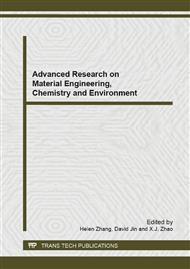[1]
Rajaguru, P., Kalaiselvi, K., Palanivel, M., Subburam, V., Microbiol. Biotechnol 54(2000) 268–273.
Google Scholar
[2]
E. Guivarch, S. Trevin, C. Lahitte, M.A. Oturan, Environ. Chem. Lett. 1 (2003) 38-44.
Google Scholar
[3]
G.M. Walker, L.R. Weatherley, Sep. Sci. Technol. 35 (2000) 1329–1341.
Google Scholar
[4]
S. Raghu, C. Ahmed Basha, J. Hazard. Mater. 149 (2007) 324–330.
Google Scholar
[5]
O. Tu nay, I. Kabdasli, D. Ohron, G. Cansever, Water Sci. Technol. 40 (1999) 237-244.
Google Scholar
[6]
J. Liu, Paper Technol. 46 (2005) 31–36.
Google Scholar
[7]
A. Slampova, D. Smela, A. Vondrackova, I. Jancarova, V. Kuban, Chem. Listy 95 (2001) 163-168.
Google Scholar
[9]
Savin II, Butnaru R. Environ Eng Manage J 7(2008) 859-64.
Google Scholar
[10]
J. C. Akan, F. I. Abdulrahman, J. T. Ayodele, V. O. Ogugbuaja. Aust J. Basic Appl. Sci 3(2009)1933-47.
Google Scholar
[11]
Kuberan T, Anburaj J, Sundaravadivelan C, Kumar P. Int J. Environ. Sci 1(2011) 1760-1770.
Google Scholar
[12]
Faryal R, Hameed A. Pak. J. Bot 37(2005)1003-1008.
Google Scholar
[13]
F. Fu, Viraraghavan T. Fungal. Bioresour. Technol. 79(2001)251-262.
Google Scholar
[14]
E. Forgacs, T. Cserhati, G. Oros, Environ. Int. 30 (2004) 953–971.
Google Scholar
[15]
A. Bhatnagar, M. Sillanpää. Chem. Eng. J. 157(2010) 277–296.
Google Scholar
[16]
A. Roessler, O. Dossenbach, W. Marte and P. Rys: submitted to Journal of Dyes and Pigments (2002).
DOI: 10.1016/s0143-7208(02)00035-9
Google Scholar
[17]
S. Komal, S. Sindhu and B. Suddhasatwa: submitted to Journal of Bioresource Technology (2013) (2012).
Google Scholar
[18]
R. Jain, M. Bhargava, N. Sharma, Ind. Eng. Chem. Res 42 (2003) 243-247.
Google Scholar
[19]
T. Bechtold, E. Burtscher and A. Turcanu. J. Chem. Technol. Biotechnol. 76(2001) 303-311.
Google Scholar
[20]
K. Aicha, B. Zohra, H. houari et al. J. Environmental Technology 33(2012) 1081-1088.
Google Scholar
[21]
V. Carolian, S. G. Uliana and Y. Hideko. J. Appl. Electochem. 42(2012) 297-304.
Google Scholar
[22]
M. Yang, R. Korneel, A. Rene et al. J. Environ. Sci. Technol. 43(2009) 5137-5143.
Google Scholar
[23]
C. Dan, G. yu-Qi, C. Hao-Yi, L. Bin, W. Ai-Jie et al. J. of Hazardous Material. 240 (2012) 257-264.
Google Scholar
[24]
A. Cardenas-Robles, E. Martinez, I. Rendon-Alcantar, C. Frontana. Bioresource Technol. 127(2013) 37-43.
DOI: 10.1016/j.biortech.2012.09.066
Google Scholar


